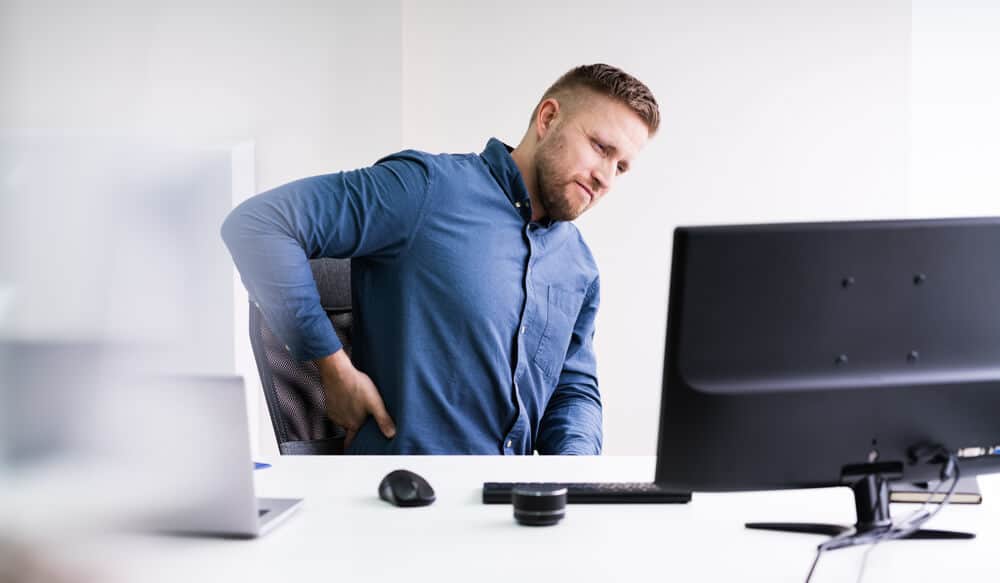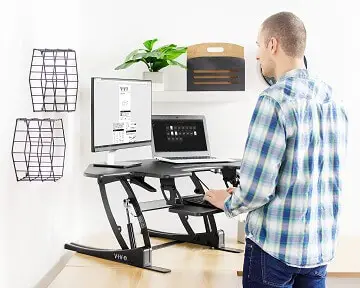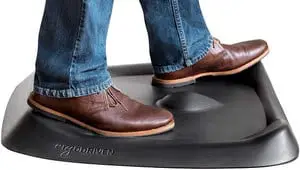At Office Solution Pro, we are passionate about Ergonomics! Our readers support the page. If you click on a link, we may earn a small commission at no cost to you. We hope you love the products we recommend as much as we do!
When discussing ergonomic office equipment, surely standing desks come to mind. They are very much in trend right now for anyone looking to reduce the risk of injury while working.
It is a public secret that sitting too much is seriously bad for your health. This is a major problem for office workers because they sit down for most of the day.
All of this may lead to poor posture, increased risk of cancer, and increased risk of obesity. Fortunately, standing desks are becoming increasingly popular.
In this article, we will take a closer look at the health risks, ways you can prevent them, the benefits of standing desks, and answer the important question of: is standing desks good for you?
The Health Risks of Excessive Sitting
Modern society is designed for sitting. As a result, more and more people are sitting down than ever before. The evidence is very clear, as numerous researchers have proven the serious health risks associated with this behavior.
As mentioned by Healhtline, some of the risks include:
- Weak legs and glutes
- Weight gain
- Tight hips and bad back
- Anxiety and depression
- Risk of cancer
- Risk of diabetes
- Varicose veins
- Deep vein thrombosis
- Stiff shoulder and neck
The reality is, more than half of the average person’s day is spent sitting down, doing activities such as driving to work, working behind a desk, and watching television.
The sad part of this modern day and age is that many are spending more than eight hours a day sitting down at work, only to return home to sit around some more.
Even worse yet, studies have shown that even if you exercise vigorously during the week, it does not help much to offset the risks associated with too much time spent sitting.

The Solution to Sedentary Lifestyle
You might think that simply replacing sitting with standing will solve the whole problem. While it’s true that it may be better than sitting, merely standing up is not as beneficial as you would think. The main goal is for you to become a more active person.
Research suggests that the simple act of movement triggers important metabolic functions within your body. Not only does it help burn calories, helping you lose weight, but it also improves your mood and helps produce changes in the parts of your brain that regulate stress and anxiety.
Simply put, moving more means it can help you feel happier. 🙂
When you sit down for too long, vital functions in your body end up stalling. This will lead to an increased risk of developing chronic diseases and serious health complications.
Are Standing Desks the Answer?
There are several things that you can do to become more active, especially if you are someone who is required to spend a lot of time sitting down.
The general rule of thumb is to take a break for every 30 to 60 minutes you work. Whether you are stretching your body, getting a glass of water, or even taking a brief walk — finding ways to incorporate more movement into your day is the way to go!
With that in mind, getting a standing desk can help promote better health. Provided that you understand the right way to use it properly. However, it’s important to note that getting a standing desk should only be the first step to becoming more active.
To help you make better decisions, let’s go over some of the ergonomic benefits of standing desks.

The ultimate goal is to lead a more active lifestyle.
Benefits of Standing Desk
1. Lowers Risks of Weight Gain and Obesity
While performing exercises is the most effective way to burn calories, simply choosing to stand up while working can be beneficial as compared to sitting down.
In fact, an equal amount of working time standing in one afternoon has been shown to burn over 170 additional calories compared to working while sitting.
2. Lowers Risks of High Blood Sugar
Studies show that using a standing desk at work can lower blood sugar levels, especially after lunch. The University of Queensland found that standing an extra two hours a day may help lower the average fasting blood sugar levels by 2 percent and lower the average triglycerides by 11 percent.
This could help explain why excessive sitting time — especially after meals — may contribute to a jaw-dropping 112 percent greater risk of type 2 diabetes.
3. Reduces Back Pain
Back pain is one of the most common complaints of office workers who sit all day.
Studies have been done on employees with long-term back pain to determine whether standing desks can help solve this problem. After several weeks of using standing desks, participants have reported up to 32 percent improvement in lower back pain.
4. Improve Moods and Energy Levels
One study found that standing desks can help lower feelings of stress and fatigue, while helping to improve mood and energy levels.
This is a great win-win if you are considering to invest in a standing desk, as transitioning from sitting to standing can greatly improve your overall work-day at the office.
5. Boosts Productivity
As mentioned earlier — with your improved mood and energy levels — you may see increased levels of productivity. Becoming more active can help stimulate blood flow to your brain.
If you have set your standing desk to the right height, then you fill find comfort and ease during your work time. Having both physical and mental energy will allow you to accomplish more tasks in less time.
6. Helps You Live Longer
Given the strong link between chronic diseases with extended sedentary time, it’s not surprising that studies have found an association between increased sitting time and early death.
A study has estimated that reducing sitting time to 3 hours per day would raise the average American’s life expectancy by 2 years!

Conclusion
While working at a standing desk clearly has major benefits for your life, it’s important to remember that it is only a tool to help you become more active.
Reducing a sedentary lifestyle can improve physical, metabolic, and even mental health. This is why sitting less and standing more is something important for you to start doing.
If you are someone who is concerned with the amount of time you spend sitting down, we would highly recommend that you invest in a standing desk converter as the first step towards a more active and healthier lifestyle.
Remember, the best thing you can do for your health is to become more active! If you follow everything that we’ve written in this article, you will greatly maximize the ergonomic benefits of standing desks.
Have you wondered how tall a standing desk should be? Read “how tall is a standing desk”
Just remember to stand in a neutral position and maintain a proper standing posture while moving throughout your day!
Citations
- Medically reviewed by Jake Tipane, CPT — By Marcy Crouch PT, DPT, CLT, WCS on September 27, 2021
- Buckley JP, Mellor DD, Morris M, Joseph F. Standing-based office work shows encouraging signs of attenuating post-prandial glycaemic excursion. Occup Environ Med. 2014 Feb;71(2):109-11. doi: 10.1136/oemed-2013-101823. Epub 2013 Dec 2. PMID: 24297826.
- Ognibene GT, Torres W, von Eyben R, Horst KC. Impact of a Sit-Stand Workstation on Chronic Low Back Pain: Results of a Randomized Trial. J Occup Environ Med. 2016 Mar;58(3):287-93. doi: 10.1097/JOM.0000000000000615. PMID: 26735316.
- Pronk NP, Katz AS, Lowry M, Payfer JR. Reducing occupational sitting time and improving worker health: the Take-a-Stand Project, 2011. Prev Chronic Dis. 2012;9:E154. doi: 10.5888/pcd9.110323. PMID: 23057991; PMCID: PMC3477898.
- Katzmarzyk PT, Lee IM. Sedentary behavior and life expectancy in the USA: a cause-deleted life table analysis. BMJ Open. 2012 Jul 9;2(4):e000828. doi: 10.1136/bmjopen-2012-000828. PMID: 22777603; PMCID: PMC3400064.






